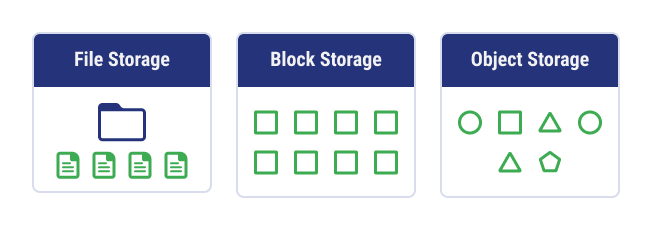
The influx of big data, complex workloads, artificial intelligence, and machine learning has led to a growing need for data storage solutions. It’s estimated that 200 zettabytes of data will be stored by 2025.
One way businesses can contend with this demand is through storage as a service (STaaS). Available on-premises or in the cloud, STaaS solutions offer access to compute and storage resources to organizations on an as-needed basis. Adding STaaS to your framework can help you face today’s storage challenges, but the benefits need to be weighed alongside performance and security considerations.
Understanding Today’s Storage Challenges
With such a huge growth in data production comes a greater need to store and manage it. Businesses often face challenges related to capacity, scalability, security, and the rising costs of on-premises storage.
On-premises systems have a set storage capacity businesses can fill. Data volumes are expanding both in the number of sources, as well as the amount of data being produced per source. Sensor data, video files, and generative AI programs, for example, produce large amounts of data that need to be stored and analyzed to be useful, secure, and compliant.
Keeping this sensitive data safe means that businesses need a strong storage plan that includes encryption, access controls, backups, and disaster recovery methods. Data coming in more and from different sources means there is more to manage and protect.
If you run out of room on-premises, you’ll have to scale up your traditional infrastructure, which can be a significant investment and tack on a lot of extra time and money for setup and maintenance. This is especially expensive for variable storage needs because organizations run the risk of paying to house infrastructure that goes unused or underutilized.
Paying for the hardware is one part of the expenses, but ongoing costs for on-premises storage also include cooling, power, staffing, and the physical real estate costs related to taking up more space.
Even with a larger footprint, at some point, on-premises storage solutions can be limiting. There’s only so much hardware you can add, people you can staff, and maintenance you can do, especially if you have a small in-house IT team that needs to be focused on other matters.
What is Storage as a Service?
Storage as a service (STaaS) is a cloud-based storage model similar to software as a service (SaaS) where businesses gain on-demand access to storage resources, either on-premises or in the cloud. Instead of having to purchase and maintain physical hardware, organizations can use STaaS and scale resources in the cloud based on their current storage needs. This eliminates upfront costs and often cuts down on wasted resources.
How Does Storage as a Service Work?
A multi-layered architecture and key components combine to make storage as a service work for businesses.
Architecture
The architecture of STaaS includes the following:
- User Interface: This is what businesses use to access the service, manage settings, perform basic tasks, and monitor what is being used.
- API Gateway: This is the point of entry for requests, where commands that come in from the user interface are transformed into instructions for the storage system.
- Management Layer: Storage resources, user access controls, and system health can be set and changed in this layer.
- Storage Layer: Of course, the most important part of STaaS is the storage layer, where technologies such as solid-state drives (SSDs) and hard disk drives (HDDs) are used to house data.
- Networking Layer: When data needs to be transferred to and from the user interface, API gateway, and storage layer, it uses the networking layer’s connection to move around large data volumes.
Key Components
There are a few key components within STaaS architecture, including storage hardware, replication and redundancy measures, security controls, and management tools.
Storage hardware is likely to be provisioned based on access and performance needs for certain data. Less frequently accessed information can reside on HDDs, whereas high-performance SSDs should be prioritized for data that is used and changed often.
Replication and redundancy measures in STaaS can include saving data in multiple geographical locations, as well as having redundancy in the facilities themselves, such as extra power and cooling methods.
Even with a failback available, it’s important to protect data from cyberattacks or unauthorized access. Service providers do this with encryption in transit and at rest, user access controls, and intrusion detection systems that can flag behavioral anomalies. At the management layer, STaaS services will have a suite of management tools to configure capacity thresholds, storage monitoring, user roles, and more.
Types of Storage in STaaS
The primary STaaS offerings are file storage, object storage, and block storage, which can fit different access patterns and data needs.

File Storage
File storage most closely resembles how data is organized on a local computer. With file storage, data is organized in folders and sub-folders, allowing users to access data hierarchically based on agreed-upon conventions.
Object Storage
Unstructured datasets can be housed in object storage. This is best for large archives, log data, and media files, where finding specific objects is important but not a frequent practice.
Block Storage
Block storage is the most similar to traditional hard drives. Data is stored in fixed-sized blocks, making this method ideal for running applications, databases, and virtual machines, or when data needs to be accessed in a prescribed order.
Benefits of Storage as a Service
Storage as a service can resolve common storage struggles and improve scalability, resiliency, and cost-efficiency for businesses looking for a more flexible, manageable alternative to on-premises storage.

Scalability
A growing archive shouldn’t stop you in your tracks. STaaS has on-demand scalability that adjusts to your needs. Simple scaling cuts down on wasted resources.
Disaster Recovery
One major benefit businesses can enjoy with STaaS is added redundancy and data replication that makes disaster recovery smoother. Even if one storage device becomes corrupted or is targeted by a data breach, for example, redundancy means that organizations can switch over to a geographically distinct location to access a copy of their data. Most STaaS providers will include replication of data as part of their offerings. Redundancies can also include components like multiple sources of power, networking, and cooling at a facility.
Cost Efficiency
On-premises storage infrastructure is based mainly on capital expenditures, upfront hardware and facility investments that can take years of use to pay off. STaaS removes upfront costs and offers storage on a pay-as-you-go basis with an operating expenditures (OpEx) model. This can significantly reduce expenses, particularly for businesses with changing storage needs.
What to Consider Before Implementing Storage as a Service
Handing off storage services to an outside provider can simplify storage and improve flexibility, but there are some factors you should evaluate prior to implementation.
Data Privacy and Security Concerns
Not all providers are made equal. Make sure you understand the security practices of the STaaS providers you’re evaluating and how they are keeping your sensitive data safe in the cloud, as well as any responsibilities your business may have to add security measures. If your data is subject to certain data privacy regulations, such as HIPAA or GDPR, you’ll want to work with a provider that can keep you compliant.
Latency and Performance Issues
Applications that require real-time data access work best with storage solutions that are built for performance. Choosing the wrong type of storage can increase latency and make for a poorer user experience. Performance can also be hindered if data is stored geographically far away from users.
Cost Management
An OpEx model can be beneficial in many different scenarios, but that doesn’t mean it’s right for everyone. Predictable storage needs may be better suited for upfront investments, but it’s important to run the numbers for both scenarios to be sure.
You’ll also want to put monitoring in place for usage to ensure the storage you have is being used wisely. Not all data needs to be saved, so having a protocol for archival and deletion is a key part of keeping costs low.
Who Can Benefit from Storage as a Service?
Most industries can benefit from STaaS in some way because the offering is so versatile. However, it’s best in use cases involving high-performance computing, storing large video and audio files, and securing medical records.
Some potential use cases include:
- Scaling storage for a massive dataset to keep analysis going
- Storing large files in the cloud for efficient remote collaboration
- Holding sensitive patient data in compliance with relevant regulatory standards
- Offering a backup location for on-premises data
- Storing data closer to the “edge” of the network for improved performance
Is Storage as a Service Right for Me?
Storage as a service is right for many different types of businesses and scenarios. Organizations looking for greater flexibility, scalability, and access can find these benefits in STaaS, and it can serve as a valuable part of your hybrid cloud infrastructure. Interested in learning how to incorporate STaaS? At TierPoint, we’re here to help. Contact us to learn more.

